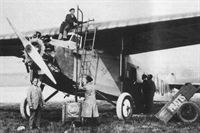Фотографии
-
Регистрационный номер: H-NADK A KLM Fokker F.VII being refuelled at Croydon in 1927. It is fitted with a twisted slab dural propeller, presumably of German origin.
Самолёты на фотографии: Fokker F.VII / C-2 / F.XIV - Нидерланды - 1924
-
The smoothly-streamlined cowlings of the Supermarine S.6 concealed a 1,900 h.p. Rolls-Royce R engine, nothing is visible but the exhaust ports. Note the coarse pitch of the propeller.
Самолёты на фотографии: Supermarine S.5 / S.6 - Великобритания - 1927
-
Hard Work Ahead: A.V. Roe smiles philosophically in front of his early machines after a fairly typical landing - the metal paddle-bladed propeller is severely bent, but in one piece.
The "crash" was the result of outgrowing his "aerodrome," for on one occasion he remained up until the boundary line was reached, and attempting to turn resulted as shown! This machine was the forerunner of the tractor-fuselage types of aircraft which became common in subsequent years.Самолёты на фотографии: Avro Triplane I - III - Великобритания - 1909
-
Регистрационный номер: NR257Y ON TEST: Col. Roscoe Turner and Mr. Clyde Pangborn flying the Boeing 247-D on a test flight before shipping it to this country. The machine is now at Heston.
The first Boeing 247 airliner was fitted with fixed-pitched metal propellers. The aircraft’s performance was enhanced considerably with the fitting of VP units.Самолёты на фотографии: Boeing Model 247 - США - 1933
-
Регистрационный номер: K3586 Hawker High-Speed Fury with Kestrel engine and an experimental radiator installation. The two-bladed wooden propeller was characteristic of most fighters of the period.
Самолёты на фотографии: Hawker Fury - Великобритания - 1931
-
An interesting attempt at a simple VP propeller was the American Everel, dubbed the "amputated airscrew". The blade was pivoted on an oblique bearing and reacted to centrifugal and aerodynamic forces to change pitch through a limited range. It could be used only on small, low-powered aircraft, like the Cub.
Like most unorthodox pieces of machinery, the Everel airscrew looks a little uncouth until one becomes used to its appearance.Самолёты на фотографии: Taylor Cub - США - 1931
-
Регистрационный номер: J6852 The massive 68ft-span Avro Aldershot heavy bomber prototype, J6852, powered by a 1,000 h.p. Napier Cub. The man standing at right gives some idea of the size of the wooden four-bladed propellar.
Самолёты на фотографии: Avro Aldershot / Type 549 - Великобритания - 1922
-
Unorthodox laminated wooden propeller on an airborne plumber’s nightmare, the Sablatnig PI of 1919.
Самолёты на фотографии: Sablatnig C.I/C.II/N.I/P.I - Германия - 1917
Статьи
- -
- DHC-1 Chipmunk VH-UPD /Preservation Profile/
- Personal album. Civil
- Plane Crazy
- Skywriters
- B.Johnson - The first of the jets
- D.Edwards - Memoirs of a Burma staff wallah (2)
- D.Middleton - Propellers (1)
- D.Muscroft - Shuttleworth sunday
- I.Martin - In at the deep end
- J.Stroud - Breguet 764 Deux Ponts /Post-war propliners/
- M.Oakey - Grapevine
- M.Retallack - Wings training in Southern Rodesia (1)
- P.Jarrett - By day and by night /The classic inter-war RAF biplane bombers/ (2)
- P.Taylor - The demise of WD933
- R.Beamont - Tempest summer
- S.Harding - The Boomerang's return
- W.Morse - Baynes: the unknown innovator







